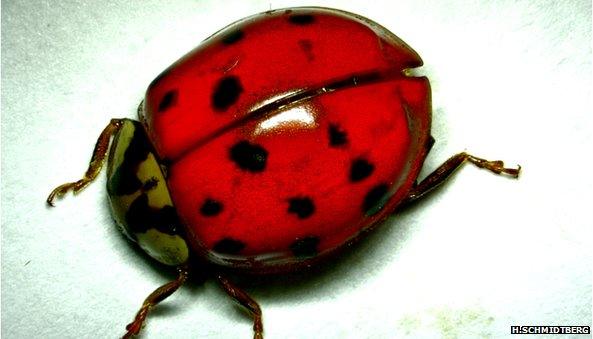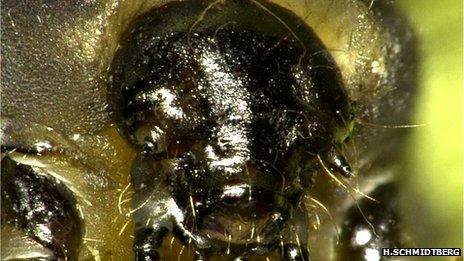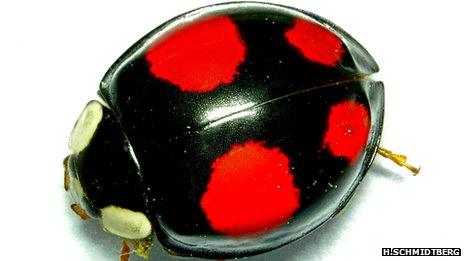Invasive ladybirds wage 'biological war' on natives
- Published

The Asian Ladybird or harlequin has overpowered native species across Europe
German researchers have discovered the biological keys to the success of an invasive species, wreaking havoc across Europe and the US,
The Asian ladybird was originally brought in to control aphids in greenhouses.
But it has escaped and is increasing uncontrollably across Europe, wiping out native species.
The alien is winning, say scientists, because its body fluid contains a parasite toxic to other insects.
The research, external is published in the Journal, Science.
Sometimes called the harlequin, the Asian ladybird (Harmonia axyridis, external) can devour over two hundred aphids a day.
They are seen as a natural and effective solution to the problems posed by these pests, external in greenhouses.
Killer bugs
But in recent years these imported ladybirds have escaped, external and rapidly established themselves across Europe and North America at the expense of native species.
In Autumn, the Asian invaders can be a nuisance as they congregate in large groups searching for sheltered locations to hibernate.
They can sometimes cause serious allergic reactions, external in humans.

The larvae of the Asian ladybird can poison any native who eats it
In this new research, scientists have shown that it is the biological system of the Asian ladybird that gives it the edge when it comes to competing with native species.
The invader has an extremely powerful immune system.
The body fluid of the insect contains a strong antibiotic compound called harmonine as well as antimicrobial peptides. These allow the invasive to fight off pathogens more effectively than natives.
So powerful are the antibiotic elements in the ladybird, that the researchers say they may prove to be promising targets for drug development.
But the most powerful aspects of the ladybird's biological armoury are tiny fungi called microsporidia, external.
"They keep them inactive in their own blood, we don't understand how they do it yet," said Dr Heiko Vogel from the Max Planck Institute for Chemical Ecology,
"But when the other ladybird beetles start to attack the invader's eggs and larvae, they become active and kill the native ones."

The ladybird's immune systems have strong antimicrobial properties
Several studies in recent years have shown the harlequin conquering other ladybirds across Europe. In the UK scientists found, external that seven of the eight native British species have declined. Similar problems have been encountered in Belgium and Switzerland.
In the UK, researchers are very keen for people to report any sightings of the harlequin. They have just launched a smartphone app, external that helps people record details of the ladybirds.
Dr Helen Roy from the Centre for Ecology & Hydrology near Wallingford, UK, said the German research was "fascinating". The outlook for native species, however, remained grim.
"The two-spot ladybird, a historically common and widespread species in Britain is suffering the most and experiencing dramatic and rapid declines," she said.
And the German scientists agree that the Asian ladybird is set to conquer most of the world.
"I don't see any which way to stop them now - it's too late in my opinion," said Dr Vogel.
"The fascinating thing is they can survive in such a wide range of temperature zones, and they are starting to pop up in South Africa and South America."
When the aphids they prey upon become scarce, Asian ladybirds are known to feed on grapes and are often found in vineyards. Their powerful, defensive chemicals can affect the taste of wine if they get trapped in the production process.
"They go on apples and grapes and that is becoming an increasing problem because of the massive amounts of these beetles, said Dr Vogel.
"The tainting of the wine with a single beetle is not funny!"
Follow Matt on Twitter, external.
- Published7 February 2012
- Published26 March 2012
- Published2 September 2011